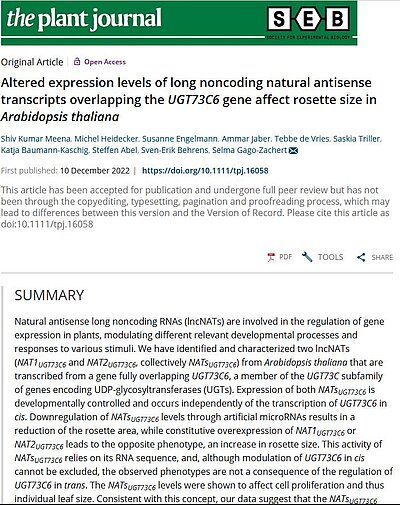Long non-coding RNAs influence rosette size in Arabidopsis.
Long non-coding RNAs (lncNATs) are currently the focus of science because they are an interesting phenomenon involved in the regulation of gene expression and in various developmental processes in ways that are still poorly understood. IPB scientists from the former Regulatory RNAs group under the direction of Dr. Selma Gago Zachert, currently at the Microbial Biotechnology department of the MLU, and collaborators have recently identified two of these lncNAT molecules from Arabidopsis and shed light on how they function. As antisense sequences, both RNAs overlap almost completely with the UGT73C6 gene, which encodes a uridine diphosphate (UDP) glycosyltransferase (UGT). Expression of the antisense sequences (NATsUGT73C6) is developmentally regulated and occurs independently of transcription of the UGT73C6 gene. By using artificial microRNAs, the Halle scientists were able to downregulate NATsUGT73C6 levels, which led to phenotypic changes in the plants such as a reduced rosette size. Overexpression of this antisenseRNA caused the opposite, the formation of larger rosettes than the corresponding wild-type plants.
Plant UDP-glycosyltransferases transfer UDP-activated sugar residues to a variety of aglycone substrates, such as hormones, secondary metabolites, and xenobiotics. Glycosylation alters the substrates' activity and solubility. For example, UGT73C6 glycosylates brassinosteroids, resulting in inactivation of these hormones. An overexpression of UGT73C6 in A. thaliana leads to brassinosteroid deficiency phenotypes with cabbage-like morphology, dark green leaves, and short petioles. Reduced expression of the corresponding inhibitory antisenseRNA NATsUGT73C6, could lead to a suppression of brassinosteroids, resulting in a similar small-roset phenotype. The differences in the rosette size of the mutants are due to changes in cell number, as the Halle scientists have shown. Changes in the transcript levels of NATsUGT73C6 thus influence leaf cell division activity. This was shown by altered expression patterns of important transcription factors.
Long non-coding RNAs are transcripts without protein-coding information. They consist of more than 200 nucleotides and are often located between the genes of multigene families with whose coding sequences they frequently overlap. Many lncRNAs have been shown in recent years to be important regulators of various biological processes. In Arabidopsis, for example, they are involved in regulatory circuits of germination, flower development, and cold acclimation. The mode of action of non-coding RNA is diverse; in plants, it is based both on translational inhibition through the formation of double-stranded RNA from sense-antisense RNA hybrids, and on other mechanisms such as transcriptional collision, influencing mRNA stability, and modulating splicing.


